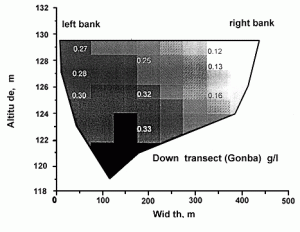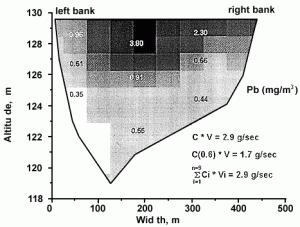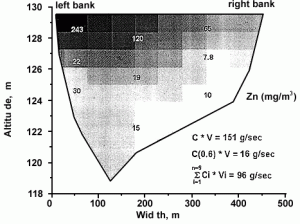Institute for Water and Environmental Problems, SB RS, Barnaul
Head of the Institute:
Yuri I.Vinokurov, Doctor of Geographical Sciences, Professor
105 Papanintsev Str., Barnaul, 656099, Russia;
Tel. ++7(3852)367855;
Fax ++7(3852)240396;
email: vinokurov@iwep.secna.ru
Principal researchers:
T.S.Papina, Ph.D.
V.V.Kirillov, Ph.D.
S.A.Mikhailov, Ph.D.
Project objectives
Development of scientifically justified techniques for prediction of water quality of rivers characterised by prolonged ice-covered period and pronounced spring flood as well as the substantiation of the procedure for pollution assessment of the adjacent watershed river on the content and specific matter of pollutants distribution in the following system: water – suspended matter – phyto – zooplankton – bed sediments – phyto – zoobenthos, hydromacrophytes.
Background and significance of objectives
The project submitted continues our research staff’s investigation in 1) assessing the pollutants entering due to snow melting into the river channel system in the industrial centre area; 2) studying structural and functional peculiarities of aquatic ecosystem; 3) assessing water quality using bioindication and biotesting techniques. Within the framework of the project, peculiarities of the distribution of pollutants coming from the watershed surface will be studied considering the components of the river ecosystem with due regard to a specific nature of the spatial and temporal distribution within each component. This will allow river water quality to be predicted for different hydrological periods of the year. The investigations the taking into account spatial and temporal aspect are of great importance: the established irregularity in the distribution of pollutants transported by river suspended matter in the area of Barnaul city throughout the spring snow melting period effectively proves it (Figs. 1, 2).
At present all around the world nature monitoring studies are being carried out within the scope of various scientific projects; wide experience in studying and predicting of sea and river water quality has been gained. However the investigations mentioned above are carried out for rivers of warm and moderate climates (Western and Eastern Europe, North and South America). Obviously, hydrologic and hydrochemical regimes of these rivers differ greatly from the ones of Russian northern rivers. That is why the research experience gained and various verification models for predicting water quality of warm and moderate climate rivers are unacceptable for quality prediction of northern rivers with a prolonged ice-covered period. So, the investigations scheduled within the framework of the project are much of current interest.
Research plan: approaches and methods
It has been known that pollutants coming to the river from the watershed basin are rapidly redistributed on major components of the water ecosystem. As a result, most of them are accumulated by hydrobionts and stored in bed sediments. The distribution and income rate of pollutant burial depends on the granulometric and chemical content of suspended matter, its accessibility for hydrobionts, the chemical compound of water, the kinetics of river channel processes and the processes that occur on the water/suspended matter (SM) – bed sediments (BS) interface. The given project is aimed at obtaining the quantitative assessment (based on field data and biotesting results) of transport and distribution of conservative pollutants entering the Ob River in the area of Barnaul city during different hydrological periods. For the purposes the following work will be carried out :
- Sampling of water, different suspended matter and bed sediments fractions, in various hydrologic periods of the year (snow flood, main flood, summer low water, flood in summer and autumn, low water in autumn and winter);
- Complex field investigations of phyto and zoocenosis (phyto, zooplancton, phyto-, zoobenthos, hydromacrophytes) during a year period including the ice covered one;
- Analysis of samples for the content of conservative pollutants (resistant organic and mineral matter, toxic metals). Moreover, it is planned to carry out total hydrochemical analysis of water as well as granulometric and mineralogical analysis of suspended matter and bed sediments;
- Experiments on assessment of water quality by a biotesting technique carried out under laboratory conditions.
- Developing a mathematical model for assessment of water quality parameters at the river site considering pollutants coming from point and non-point sources of pollution.
Expected results
The field data to be obtained as well as the data on river channel processes and the processes on the suspended matter – bed sediments interface will allow us to estimate the actual intensity and extension of local polluted sites throughout different hydrological periods and assess contamination impact on water quality, structural and functional features of hydrobiont communities. The expected results will be the substantiation of a procedure for prediction of river water quality near large industrial centres for rivers with a lasting ice-covered period and prominent spring flooding, which is new and pressing in this field of knowledge. It is planned to use the results obtained as a basis for estimation of seasonal maximum allowable damage effects of matter released by industrial enterprises into the river.
List of publications of participants related to the project
-
Yenkal S.I., Metrofanova Ye.Yu., Materials on Bacillariophyta flora of Lake Teletskoye (Altai Territory, Russia) // Algae science. – 1995. – Vol. 4. – P. 375-377 (in Russian).
-
Yegorkina Y.I. Vegetation role in assessment of genotoxic chemical and polluted environments // IWEP, SB RAS, Barnaul, 1996. – 24 p. (in Russian).
-
Yegorkina Y.I., Zarubina Ye.Yu., Kirillov V.V. Aquatic plants used for assessment of genotoxic surface water // Sierian G. Ecol. (in print, in Russian).
-
Mitrofanova Ye.Yu. Phytoplankton of Lake Teletskoye, Barnaul. – 1993.
-
Papina T.S., Temerev S.V., Eirikh S.S. Mercury in the Tom River basin // Chemistry for sustainable development. – 1999. – Vol. 22. – P. 147-151 (in Russian).
-
Papina T.S., Temerev S.V., Eirikh A.N. Factors effecting heavy metals distribution within aquatic ecosystems of middle and low Ob / Siberian G. Ecol. (in print, in Russian).
-
Romanova N.S. Changing of biological parameters of Cladocera conchoidal of Dahpniidae (Straus) family exposed by Ob river water // Siberian G. Ecol. – 1997. – Vol. 4, ą 2 (in Russian).
-
Rudneva L.V. Structure of benthos communities and mercury content in larvae of amphibiotic insects in the Katun River basin channels // Siberian G. Ecol. – 1997. – ą 2. – P. 167-172. (in Russian).
-
Safonova T.A., Metrofanova Ye.Yu. Materials for studying of species algae compound of Lake Telietskoye (Gorny Altai, Russia) // Algae Science. – 1998. – Vol. 8, ą 1. – P. 3-10. (in Russian).
-
Sukhenko S.A., Krissinel Ye.B., Michailov S.A. Prediction of the Katun River regulation impact on mercury transport from occurrence sites // Meteorology and hydrology. – 1993. – Vol. 3. – P. 47-53 (in Russian).
-
Sukhenko S.A., Krissinel E.B., Mikhailov S.A. Impact of river regulation on mercury transport / Hydrological, Chemical and Biological Processes of Transformation and Transport of Contaminants in Aquatic Environments. – IAHR Publ. No. 219, 1994. – P. 285-292.
-
Vasiliev O.F., Papina T.S., Eyrikh S.S., Sukhenko S.A. Mercury in the Katun river basin: a case study of a naturally polluted system // Proc. of NATO ARW. Global and regional mercury cycles: sources, fluxes and mass balances / Eds. W. Baeyens, R. Ebinghaus, O. Vasiliev. – Dordrecht: Kluwer Academic Publishers. – 1996. – P. 273-284.
Fig.1. Cross-cut profiles of suspended sediments (Ob-river; 13.05.1998)
Fig.2. Cross-cut profiles of Pb, Zn transported by suspended sediments (Ob-river; down transect, 13.05.1998)




